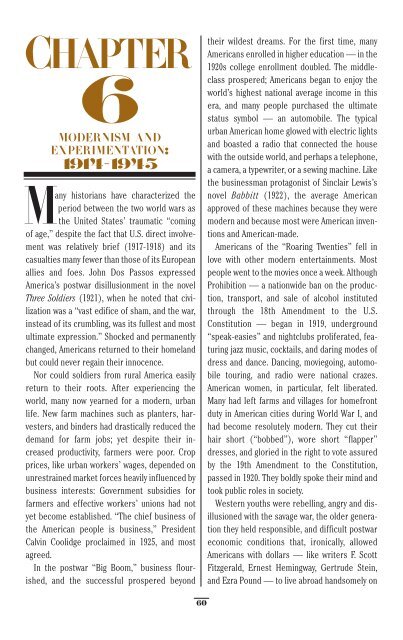outline_us_lit
outline_us_lit
outline_us_lit
Create successful ePaper yourself
Turn your PDF publications into a flip-book with our unique Google optimized e-Paper software.
CHAPTER6MODERNISM ANDEXPERIMENTATION:1914-1945Many historians have characterized theperiod between the two world wars asthe United States’ traumatic “comingof age,” despite the fact that U.S. direct involvementwas relatively brief (1917-1918) and itscasualties many fewer than those of its Europeanallies and foes. John Dos Passos expressedAmerica’s postwar disill<strong>us</strong>ionment in the novelThree Soldiers (1921), when he noted that civilizationwas a “vast edifice of sham, and the war,instead of its crumbling, was its fullest and mostultimate expression.” Shocked and permanentlychanged, Americans returned to their homelandbut could never regain their innocence.Nor could soldiers from rural America easilyreturn to their roots. After experiencing theworld, many now yearned for a modern, urbanlife. New farm machines such as planters, harvesters,and binders had drastically reduced thedemand for farm jobs; yet despite their increasedproductivity, farmers were poor. Cropprices, like urban workers’ wages, depended onunrestrained market forces heavily influenced byb<strong>us</strong>iness interests: Government subsidies forfarmers and effective workers’ unions had notyet become established. “The chief b<strong>us</strong>iness ofthe American people is b<strong>us</strong>iness,” PresidentCalvin Coolidge proclaimed in 1925, and mostagreed.In the postwar “Big Boom,” b<strong>us</strong>iness flourished,and the successful prospered beyondtheir wildest dreams. For the first time, manyAmericans enrolled in higher education — in the1920s college enrollment doubled. The middleclassprospered; Americans began to enjoy theworld’s highest national average income in thisera, and many people purchased the ultimatestat<strong>us</strong> symbol — an automobile. The typicalurban American home glowed with electric lightsand boasted a radio that connected the ho<strong>us</strong>ewith the outside world, and perhaps a telephone,a camera, a typewriter, or a sewing machine. Likethe b<strong>us</strong>inessman protagonist of Sinclair Lewis’snovel Babbitt (1922), the average Americanapproved of these machines beca<strong>us</strong>e they weremodern and beca<strong>us</strong>e most were American inventionsand American-made.Americans of the “Roaring Twenties” fell inlove with other modern entertainments. Mostpeople went to the movies once a week. AlthoughProhibition — a nationwide ban on the production,transport, and sale of alcohol institutedthrough the 18th Amendment to the U.S.Constitution — began in 1919, underground“speak-easies” and nightclubs proliferated, featuringjazz m<strong>us</strong>ic, cocktails, and daring modes ofdress and dance. Dancing, moviegoing, automobiletouring, and radio were national crazes.American women, in particular, felt liberated.Many had left farms and villages for homefrontduty in American cities during World War I, andhad become resolutely modern. They cut theirhair short (“bobbed”), wore short “flapper”dresses, and gloried in the right to vote assuredby the 19th Amendment to the Constitution,passed in 1920. They boldly spoke their mind andtook public roles in society.Western youths were rebelling, angry and disill<strong>us</strong>ionedwith the savage war, the older generationthey held responsible, and difficult postwareconomic conditions that, ironically, allowedAmericans with dollars — like writers F. ScottFitzgerald, Ernest Hemingway, Gertrude Stein,and Ezra Pound — to live abroad handsomely on60


